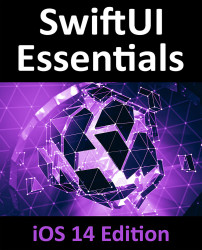54.1 An Overview of the Hosting Controller
The hosting controller (in the form of the UIHostingController class) is a subclass of UIViewController, the sole purpose of which is to enclose a SwiftUI view so that it can be integrated into an existing UIKit-based project.
Using a hosting view controller, a SwiftUI view can be treated either as an entire scene (occupying the full screen), or as an individual component within an existing UIKit scene layout by embedding a hosting controller in a container view. A container view essentially allows a view controller to be configured as the child of another view controller.
SwiftUI views can be integrated into a UIKit project either from within the code or using an Interface Builder storyboard. The following code excerpt embeds a SwiftUI content view in a hosting view controller and then presents it to the user:
...



